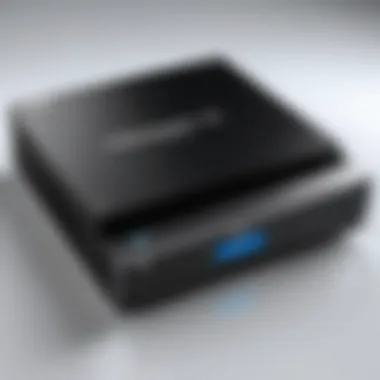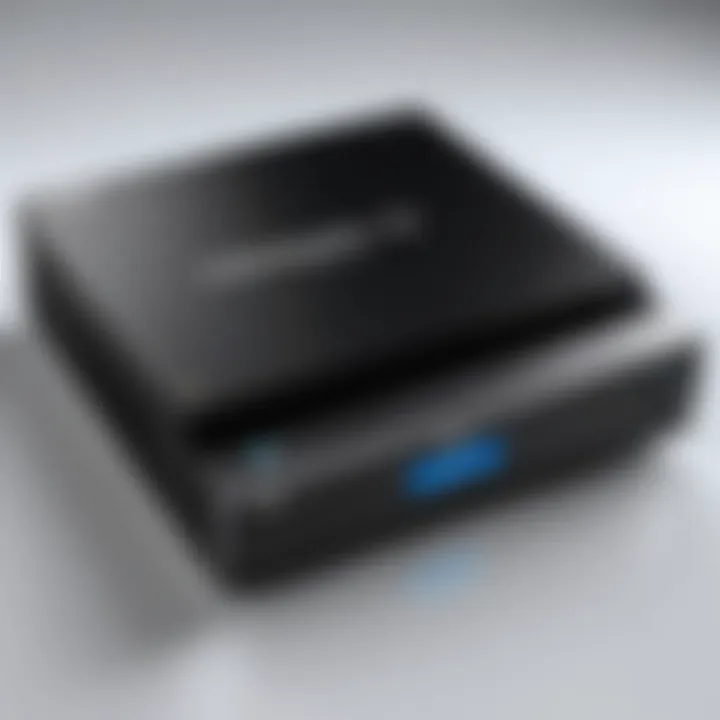Comprehensive Guide to Windows 10 DVD and Blu-ray Players


Intro
The landscape of media playback in Windows 10 is increasingly relevant as consumers continue to value high-quality visual experiences. Understanding how to effectively utilize DVD and Blu-ray players is indispensable for IT professionals and tech enthusiasts alike. Windows 10 provides a range of options for this functionality, from built-in solutions to third-party software. This article aims to explore various tools and considerations that aid in achieving optimal playback.
Delving into the compatibilities and performance nuances associated with different media tools will equip users with essential knowledge. Moreover, it will aid in deciphering the operational requirements and limitations often faced during media playback. A comprehensive understanding of these aspects can significantly enhance the user experience, thereby facilitating more informed decisions when it comes to media consumption on Windows 10.
Prelims to Media Playback on Windows
Media playback on Windows 10 plays a crucial role in how users experience video and audio content. With the predominance of digital media, the ability to access and play DVDs and Blu-rays remains relevant. Understanding this functionality helps users make informed decisions about their media consumption. This article examines both built-in and third-party applications that enable playback, thereby offering insights that can enhance user engagement with multimedia.
Understanding and Blu-ray Formats
DVD, short for Digital Versatile Disc, revolutionized home entertainment by allowing users to watch films and store data in a compact format. DVDs can hold about 4.7 GB of data in their single-layer design, while a dual-layer disc can store up to 8.5 GB. Conversely, Blu-ray discs significantly expand the storage capacity, offering up to 25 GB on a single-layer and 50 GB on a dual-layer format. The advanced compression techniques utilized in Blu-ray technology deliver higher picture and audio quality, which is particularly beneficial for high-definition content.
The format differences necessitate specific software for the type of media. For instance, playing a Blu-ray typically requires different decoding than a standard DVD. It is essential for users to understand these distinctions to ensure optimal playback experiences. Furthermore, the physical hardware on which these formats are used—such as the optical drive—plays a significant role in determining compatibility and playback success.
Evolution of Windows Media Playback
The development of media playback in Windows has mirrored the advancements in technology itself. From early editions of Windows, which lacked robust support for multimedia, to Windows 10, there has been significant progress. Windows Media Player was initially the central application for handling all types of media. Its user interface offered basic playback functions and playlist management, but it had limitations in supporting newer formats, especially Blu-ray.
In response to evolving needs, Microsoft introduced the Windows DVD Player app, which provided a solution for users needing to play DVDs. However, users often found that it is limited in functionality compared to third-party alternatives. As the landscape of media consumption changes, the demand for more versatile and capable software continues to grow. This reflects a broader trend toward integration and adaptability in technology, underlining the importance of keeping media playback options updated in response to user needs.
Built-In Options for and Blu-ray Playback
Understanding the built-in options for DVD and Blu-ray playback is critical for maximizing the Windows 10 multimedia experience. The ability to play these formats natively is essential, as it reduces reliance on third-party software, thus streamlining the user experience. Built-in solutions not only provide convenience but also tend to have better system integration, enhancing overall performance. Users benefit from a seamless interface and often receive updates alongside the operating system. Moreover, leveraging these built-in tools minimizes compatibility issues that can arise with external applications.
Windows Media Player Overview
Windows Media Player is one of the oldest media players in the Windows ecosystem. While its primary purpose has evolved over the years, it remains relevant for those seeking to play DVDs. When using Windows Media Player, users can effortlessly access their media library, including video and audio files.
With Windows 10, Windows Media Player expands its capabilities to include DVD playback, relying heavily on the system's core functionalities. However, it is significant to note that its ability to handle Blu-ray formats is generally limited. Users might encounter difficulty playing certain discs, especially newer releases that incorporate advanced encryption.
In terms of usability, Windows Media Player offers a clear and straightforward interface. It is intuitive, allowing even less technically inclined users to engage with the software easily. Some key features include playlists, media library organization, and basic editing functionalities. The performance of Windows Media Player is generally reliable but may lack some advanced options seen in dedicated software.
Windows Player App
The Windows DVD Player app is a direct response to the widening gap in media playback options since many users shifted to digital formats. This app has a simple design that caters to ease of use, performing the primary function of DVD playback without additional complexities. Unlike Windows Media Player, the Windows DVD Player app is tailored specifically for DVD media, making it a more robust solution for those primarily looking to play DVDs.
This app supports a wide range of DVD formats, including those encoded with enhanced protection. Users can expect minimal issues when watching content, as the app optimizes the playback process.
However, unlike many third-party options, the Windows DVD Player app does require a purchase, which can be a consideration for users seeking free alternatives. One clear advantage is its integration into the Windows ecosystem, allowing updates through Microsoft.
In summary, while built-in options such as Windows Media Player and the Windows DVD Player app have their limitations, they provide users with direct functionality for DVD playback. For those focusing on DVDs rather than Blu-ray, these options can be sufficient, albeit some users may need to explore third-party applications for enhanced Blu-ray functionality or additional features.
Third-Party Software for Playback
Third-party software is essential for anyone using Windows 10 for DVD and Blu-ray playback. While built-in options like Windows Media Player and Windows DVD Player are available, they may not meet every user's needs. This is where third-party applications come into play, offering a wider array of features and improved performance. Many of these software solutions come with advanced capabilities, allowing users more flexibility in managing their media.
Using third-party software often means accessing a richer set of functions. For instance, some players support a variety of formats that might not be recognized by native Windows applications. This factor alone can significantly enhance a user’s playback experience. Moreover, features such as customizable settings for audio and video quality, advanced subtitle support, and interactive menus can elevate media enjoyment. These elements are particularly beneficial for IT professionals and tech enthusiasts who seek a tailored media playback experience.
In addition, many third-party applications receive frequent updates. These updates often include new features, security patches, and improvements in playback technology. This ensures that the software remains current and capable of handling various media standards. Another important consideration is the user community often surrounding these applications. Support forums, tutorials, and shared experiences can greatly assist users in troubleshooting and optimizing their playback setup.


Leading Player Software Options
Several standout DVD player software options have become popular among Windows 10 users. Software like VLC Media Player remains a top choice due to its versatility and strong playback capabilities. It supports a wide range of formats without needing additional codecs. This eliminates potential hurdles when dealing with various file types.
PowerDVD is another excellent option for users who prioritize features specifically designed for DVDs. It provides a sleek interface and additional functionalities such as 4K support and advanced audio settings. This software is ideal for users wanting an enhanced experience beyond standard playback.
WinDVD is also worth mentioning. It focuses on delivering exceptional visual and audio quality. Users can adjust playback settings to suit their preferences, making it a strong contender for those who value personalization.
Choose a DVD player based on individual requirements and preferences. Each of these options has its own strengths that cater to different user needs.
Popular Blu-ray Playback Applications
When it comes to Blu-ray playback on Windows 10, Leawo Blu-ray Player is highly regarded for its comprehensive support of various Blu-ray formats. This application excels in its ability to provide lossless playback quality, ensuring that users enjoy every detail of high-definition content.
CyberLink PowerDVD also stands out in the Blu-ray category. It is famous for its powerful features, such as advanced image enhancement and support for 4K Ultra HD Blu-ray discs. Such qualities make it a favorite among those who seek the best viewing experience.
Another noteworthy application is AnyMP4 Blu-ray Player. This player is notable for its intuitive interface and support for a wide range of audio tracks and subtitles. Its capability to play Blu-ray movies without needing to install specific codecs makes it a convenient option for many.
Installation and Setup of and Blu-ray Players
The process of installation and setup is crucial for effective DVD and Blu-ray playback on Windows 10. Users must ensure that their systems are equipped and configured properly to take full advantage of media capabilities. Proper installation is not just about having the right software; it also considers hardware requirements, compatibility, and user preferences. Understanding these elements leads to a smoother experience when watching movies or accessing other media formats.
When setting up DVD and Blu-ray players, there are severalkey benefits. These include optimizing performance of the software, reducing errors during playback, and enhancing the overall user experience. Furthermore, aligning system requirements can prevent frustrating issues like lag or stuttering, ensuring that the media plays as intended.
System Requirements
Before installing any DVD or Blu-ray player software, it's essential to verify that your system meets the necessary requirements. For Windows 10, the following criteria typically apply:
- Operating System: Windows 10 version must be up to date to avoid compatibility issues.
- CPU: A dual-core processor or better is often needed for smooth playback.
- RAM: At least 4GB of RAM is recommended for running the software without interruptions.
- Graphics Card: A compatible graphics card that supports HD video playback is essential, especially for Blu-ray content.
- Disc Drive: An optical drive capable of reading DVDs and Blu-rays is mandatory.
- Hard Disk Space: Sufficient storage for installation and any additional media files should be available.
Meeting these requirements ensures a baseline level of performance and helps in avoiding playback issues later on. Without a suitable configuration, even the best playback software may fall short in delivering quality media experiences.
Installation Steps for Software
Installing DVD and Blu-ray player software on Windows 10 is a straightforward process, but certain steps should be followed to ensure successful setup. Here is a general guide for installation:
- Choose Software: Select a DVD or Blu-ray player software that meets your needs. Popular choices include VLC Media Player, PowerDVD, and CyberLink.
- Download the Installer: Visit the official website for the chosen software and download the installation package. Ensure you are downloading the most current version for best performance.
- Run the Installer: Locate the downloaded file and double-click to begin installation. If prompted by User Account Control, click Yes to allow changes.
- Configure Preferences: During installation, you may be given options to specify shortcuts or preferred settings. Adjust these according to your preferences.
- Complete Installation: Follow the on-screen instructions to complete the installation. Once finished, restart the computer if required to finalize settings.
- Test the Software: After installation, insert a DVD or Blu-ray into the optical drive to verify that the software recognizes and plays the media correctly.
Following these steps ensures a successful installation process, allowing you to enjoy a seamless media experience. If trouble arises, referring to the user manual or support forums can provide additional guidance.
"Proper setup is key to preventing playback issues and ensuring an optimal media experience on Windows 10."
Key Features of and Blu-ray Players
The selection of DVD and Blu-ray players for Windows 10 hinges heavily on their key features. These elements are both essential and appealing for users, especially IT professionals and tech enthusiasts. As media consumption trends evolve, understanding these features allows users to make informed choices about their playback experience. Several factors come into play here, including usability, performance, and quality metrics.
Interface and Usability
The interface and usability of a DVD or Blu-ray player are paramount to a smooth media playback experience. A user-friendly interface enhances ease of navigation and reduces frustration. Users expect a layout that is intuitive, allowing them to access features quickly. For instance, playback controls should be readily available, enabling play, pause, and skip actions without delay.
Additionally, features like bookmarking and chapter selection enhance usability. A well-designed interface should allow users to easily manage their viewing preferences. Screen resolutions also play a role in interface quality; higher resolutions provide clearer visuals and can impact how users interact with their media.
It is critical to evaluate how various applications align with user needs. Some players may offer simplistic designs, while others focus on a comprehensive feature set. The choice between these often boils down to user preference and technical requirements.


Playback Performance Analysis
Performance is another critical aspect of DVD and Blu-ray players on Windows 10. It includes not only the speed of loading discs but also how fluidly content plays back once it begins. Frame dropping and lag can severely detract from the viewing experience.
Factors such as the decoding process and graphics processing capabilities can influence playback performance. A player that efficiently utilizes system resources typically leads to smoother playback. Users should also consider whether their hardware may bottleneck performance. For example, high-definition Blu-ray content requires more from your system than standard DVD playback.
Finally, the responsiveness of the software during playback is equally important. Players that offer quick adjustments to playback speed or subtitle options tend to be favored by those who desire flexibility during viewing.
Audio and Video Quality Parameters
The parameters that define audio and video quality are crucial for users who take their media seriously. For DVD and Blu-ray players, items such as resolution, bitrate, and audio channels significantly influence the overall experience.
- Resolution: Different films and shows are available in various resolutions, from standard definition to full HD and ultra HD.
- Bitrate: Higher bitrates generally translate to better quality, as they allow for greater detail in images and sound.
- Audio channels: The presence of multi-channel audio systems, such as surround sound or Dolby Atmos, significantly elevates the viewing experience.
Modern players often include settings that allow users to adjust these quality parameters. This capability is especially important for those with high-end audio and visual equipment. Users should look for capabilities that match the specifications of their system to maximize their media enjoyment.
"The quality of audio and video parameters can either enhance or detract from the media experience significantly."
Balance between quality parameters and the performance of the player's features defines how satisfying the overall media playback is. Thus, it is worth investing time to assess the specific offerings of various software options to find the most compatible with your system.
Compatibility Considerations
When discussing DVD and Blu-ray players on Windows 10, compatibility considerations are critical. They ensure that users can seamlessly access media content across various formats and devices. Understanding these elements is essential for IT professionals and tech enthusiasts who seek smooth media playback solutions. The challenges often arise due to different encoding standards, system requirements, and file compatibility.
Supported Formats and Codecs
Windows 10 supports a variety of formats and codecs for both DVD and Blu-ray playback. Commonly supported formats include:
- DVD-Video
- Blu-ray Disc
- MPEG-2
- H.264
- VC-1
- AVC
While the built-in tools like Windows Media Player cover basic formats, additional codecs may be required for advanced features. Third-party solutions often come with broader codec support, enabling access to a wider array of media files.
Hardware Compatibility
Hardware compatibility plays a significant role in successful media playback. For optimal performance when using DVD or Blu-ray players, the following components are important to consider:
- Optical Drive: Ensure that the drive supports DVD and Blu-ray reading.
- Graphics Card: A capable graphics card will enhance video playback quality and decoding efficiency.
- RAM: Adequate memory helps in smooth playback without lag.
- Operating System Updates: Keeping Windows 10 updated ensures that all drivers and software work effectively with your playback tools.
It is crucial to check both software and hardware compatibility before deciding on a DVD or Blu-ray playback solution.
Understanding these compatibility aspects cannot be understated. They determine the user's overall experience while ensuring that the chosen media player effectively meets their playback needs.
Troubleshooting Playback Issues
In any media playback environment, especially for formats like DVD and Blu-ray on Windows 10, troubleshooting is a critical aspect. Many users encounter various playback issues that can range from minor irritations to complete audio-visual failure. Understanding these problems, their implications, and how to resolve them forms a vital part of a seamless media experience. For IT professionals and tech enthusiasts alike, identifying the typical challenges faced during playback is key to ensuring users maintain optimal viewing experiences.
Common Problems Encountered
Users may face several common issues when attempting to play DVD or Blu-ray content on their Windows 10 systems. Typical problems include:
- Playback Lag: This is when the video or audio does not sync, leading to a frustrating experience.
- Incompatibility with Discs: Some formats may not be supported, especially older or specialty formats.
- Software Crashes: The playback application can unexpectedly shut down, which can be quite disruptive.
- Audio Issues: No sound or distorted sound can occur, which detracts significantly from the viewing experience.
- Region Code Problems: DVDs and Blu-rays often come with region restrictions that can prevent playback on certain machines.
Being aware of these issues allows users to recognize when something is wrong and seek solutions promptly.


Solutions and Workarounds
Finding solutions to playback issues requires a systematic approach. Here are some effective strategies:
- Update Software: Ensuring that both Windows and the media playback software are up-to-date can resolve many compatibility issues. Bug fixes and enhancements are often included in software updates.
- Check System Requirements: Verify that your system meets the hardware requirements for the chosen software. Insufficient RAM or processing power may lead to playback problems.
- Change Region Settings: If region code conflicts arise, adjustments can often be made in the settings of the DVD or Blu-ray drive firmware. Be mindful of regional limits on changes.
- Consider Alternative Software: If a particular application consistently fails, trying a different DVD or Blu-ray player might yield better results. Many players have unique decoder algorithms that can handle certain formats better than others.
- Configure Audio Settings: Review the audio configurations in the software. Switching audio output options or audio device settings can often rectify sound-related issues.
- Use Media Cleaning Tools: If the disc is dirty or scratched, using a cleaning tool designed for DVDs and Blu-rays can improve playback quality.
"Troubleshooting is an essential skill in managing media playback, allowing users to minimize frustration and maximize enjoyment."
Recognizing playback issues and systematically addressing them will enhance the overall experience of using Windows 10 for DVD and Blu-ray playback.
Future Trends in Media Playback for Windows
The landscape for media playback on Windows is shifting rapidly. Understanding these future trends is essential for IT professionals and tech enthusiasts looking to stay ahead in the evolving digital environment. As digital formats gain traction, professionals face unique considerations regarding compatibility, performance, and user experience.
The Shift Towards Digital Formats
The move to digital formats has been a steady progression over the last few years. With services like Netflix, Amazon Prime Video, and Hulu gaining massive popularity, physical media plays a diminishing role in consumer media consumption. This transition not only reflects changing preferences but also aligns with convenience, available storage, and the demand for high-definition content.
Benefits of this shift include:
- Accessibility: Digital content can be accessed from various devices and locations without physical space constraints.
- Instant gratification: Users can stream or download content immediately, eliminating the need to wait for a disc to be delivered or to find the right media among a collection.
- Environmentally friendly: Reducing the use of plastic and packaging aligns with broader environmental goals.
However, this transition doesn't occur without its challenges. IT professionals must consider the need for robust internet infrastructure to support streaming services reliably. Additionally, managing digital rights and ensuring software compatibility remains a critical task.
As more users opt for digital content, understanding these dynamics becomes vital.
Potential Developments in Software
As user preferences evolve, so too does the software landscape for media playback. Several key developments are foreseen in the near future:
- Enhanced User Interfaces: Software developers strive for more intuitive interfaces that facilitate seamless navigation and playback. Simplifying the user experience can increase adoption across various demographics.
- AI-Driven Recommendations: Leveraging machine learning will enable media player applications to provide personalized content suggestions based on individual viewing habits. This could enhance user engagement significantly.
- Cross-Platform Functionality: As users shift between devices, having software that works seamlessly across platforms becomes critical. Expect advancements in remote access and collaborative viewing features that thrive in multi-device ecosystems.
- Support for Emerging Formats: With content distribution evolving, support for newer codecs and formats, such as AV1 and HEVC, will likely become standard to ensure high-quality playback across different resolutions and bandwidth conditions.
The direction of media playback software indicates a focus on enhancing user experience and maintaining relevance in a saturated market. By anticipating these changes, IT professionals can make informed decisions about software tools, ensuring optimal operating conditions for users.
In summary, the future trends in media playback on Windows reflect broader shifts in consumer behavior and technological advancements, necessitating ongoing adaptation in both hardware and software.
Closure and Recommendations
As we wrap up our exploration of DVD and Blu-ray playback options on Windows 10, it becomes clear that understanding the available software and how to evaluate your needs is essential for optimal media experience. The choice of software can significantly affect playback quality, ease of use, and responsiveness. This section aims to consolidate the information from previous discussions and guide you in making informed decisions regarding software implementation.
Evaluating Your Needs
When assessing your media playback needs, consider several factors:
- Usage Frequency: Determine how often you watch DVDs or Blu-rays. Frequent users may want to invest in a robust software solution, while occasional users could opt for free options.
- Content Type: Think about the types of content you typically view. Certain software may support special features like interactive menus or subtitles that enhance your viewing experience.
- System Specifications: Evaluate your hardware capabilities. Some applications require higher performance specifications, especially for Blu-ray playback.
- Budget Constraints: Factor in your budget for media software. While there are free options available, paid versions often offer better support and features.
These considerations can help tailor your media software choice to suit both functional and personal needs. Taking time to do this will enhance your viewing experience on Windows 10.
Recommendations for Software Choices
Based on the needs assessment, here are recommendations for DVD and Blu-ray playback software:
- VLC Media Player: This is a popular free option that supports a wide range of formats, including DVDs, and is known for its versatile playback capabilities.
- Leawo Blu-ray Player: A reliable choice for Blu-ray discs, it offers free playback and is user-friendly while also providing features like enhanced audio processing.
- CyberLink PowerDVD: Known for its extensive feature set, this paid option excels in Blu-ray playback and offers many enhancements for video quality, including 4K support.
- WinDVD Pro: This is another strong option for those who frequently use DVDs and Blu-rays, providing excellent support for various formats and additional features for an immersive viewing experience.
Before finalizing any purchase or installation, it is wise to read reviews and check compatibility with your specific system configuration. By aligning your choice with your unique preferences and needs, you can secure an optimal media playback experience on Windows 10.
"The right software enhances not just the quality of playback, but also the overall enjoyment of the media experience."
Each of these recommended software products comes with its own unique set of features, benefits, and pricing. Consider your specific preferences, and choose accordingly to achieve the best results for your media consumption.



